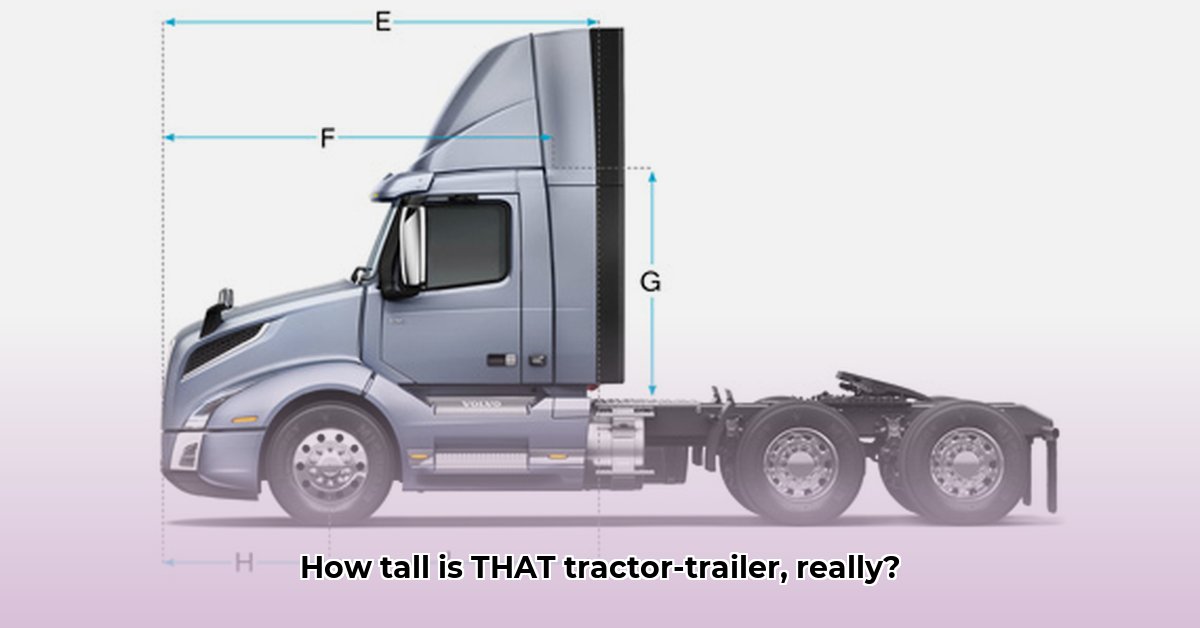
Understanding Tractor-Trailer Height Variations
The height of a tractor-trailer isn't a single number; it varies considerably. A standard dry van (the most common type) typically ranges from 13.5 to 14 feet tall. However, this height can change significantly based on several factors. Why is this important? Because understanding your truck's exact height is critical for safe and legal operation. For more detailed information, check out this helpful guide on tractor trailer heights.
Factors Affecting Height
Several key factors influence a tractor-trailer's overall height:
Trailer Type: Different trailers have different designs and heights. A flatbed trailer, for instance, is significantly shorter (4-6 feet, depending on the load) than a refrigerated trailer (reefer, approximately 13.5 to 14.5 feet) due to added insulation and refrigeration units. Specialized trailers designed for oversized loads can have even greater variations.
Cargo: The type and quantity of cargo significantly impact height. A trailer fully loaded with stacked boxes will naturally be taller than one carrying lighter or smaller items. Oversized cargo requires special permits and careful planning to ensure compliance with height regulations.
Accessories: Antennas, lights, and air conditioning units all add to the overall height. These seemingly small additions accumulate, potentially exceeding height limits if not accounted for.
Why Knowing the Height Matters: Safety, Legality, and Cost Savings
Knowing your rig's height is crucial for avoiding accidents and costly fines. Low clearances, especially under bridges and overpasses, pose a serious risk. Accidents caused by misjudged clearance can lead to:
- Damage to cargo: Significant repair costs for damaged goods.
- Truck damage: Expensive repairs for the vehicle itself.
- Injuries: Serious personal injury to drivers or others.
- Fines: Substantial fines for violating height regulations.
Accurate height knowledge, combined with the use of GPS navigation systems that include bridge height data, is your best defense against these costly and potentially hazardous situations.
Practical Steps for Safe and Compliant Driving
This guide outlines practical steps to ensure safe and legal operation, minimizing risks and maximizing efficiency.
Regular Height Checks: Before each trip, meticulously check your truck's height, including the trailer, cargo, and accessories. This is vital, especially after loading new cargo or changing trailers, as these changes will immediately alter your truck's height.
Smart Route Planning: Utilize GPS navigation systems that provide detailed information on bridge heights, tunnels, and low-clearance areas. Planning your route around these potential hazards is essential for safe travel.
Adherence to Height Regulations: Familiarize yourself with and strictly adhere to posted height restrictions. These regulations are in place for a reason – safety. Never underestimate the importance of checking and following these regulations.
Quick Height Reference Guide
The following table provides approximate height ranges for common trailer types. Remember these are estimates, and actual heights can vary based on the factors discussed earlier.
| Trailer Type | Approximate Height (feet) | Important Considerations |
|---|---|---|
| Standard Dry Van | 13.5 - 14 | Most common type; height may vary slightly by manufacturer. |
| Flatbed | 4 - 6 | Height varies greatly; entirely dependent on the load. |
| Refrigerated (Reefer) | 13.5 - 14.5 | Refrigeration unit increases height compared to dry vans. |
| Step-Deck | Variable | Designed for oversized loads; height varies significantly. |
| Double Drop | Variable | Designed for extremely tall loads to stay within legal limits. |
Avoiding Semi-Trailer Height Violations
Let's delve deeper into strategies for preventing height violations.
Measuring Your Trailer: Precision is Paramount
Never estimate your trailer's height. Use a reliable measuring tape and double-check your measurements before each journey. Accurate measurements are non-negotiable for safe and legal operation.
Route Planning: Knowing Your Limits
Utilize GPS navigation with up-to-date height data. Plan routes to avoid low-clearance areas, ensuring your trailer's height is always within legal limits. Pre-trip route planning is essential to avoid unexpected issues on the road.
Load Securing: Prevent Height Increases
Proper load securing is vital. Improperly secured cargo can shift, increasing the overall height and potentially leading to violations. Use appropriate tie-downs, straps, and other securing devices to prevent shifting and maintain a consistent height.
Regular Maintenance: Maintaining Legal Compliance
Regular maintenance can also prevent height problems. Worn-out suspension components or other damaged parts can affect the trailer’s height. Schedule regular inspections and promptly address any issues that may alter your trailer's height.
The Importance of Compliance
Height violations result in substantial risks. Fines, accidents, delays, cargo damage, and potential injuries are all serious consequences. Prioritize safety and compliance to protect yourself, others, and your cargo.